5
5.1 Introduction
LEARNING OBJECTIVES
- Explore how the US Constitution creates a limited government through the separation of powers and through checks and balances among the three branches of government.
- Learn how the US Constitution resolves conflicts between state and federal laws.
- Explore how the US Constitution grants Congress the power to regulate interstate commerce.
- Understand how the US Constitution protects the civil liberties of business entities.
Our first national constitution was the Articles of Confederation. The Articles granted limited authority to the federal government, including the power to wage wars, conduct foreign policy, and resolve issues regarding claims by the states on western lands. Many leading statesmen, known as Federalists, thought the Articles created a federal government that was too weak to survive. The lack of power to tax, for example, meant that the federal government was frequently near bankruptcy. Larger states resented the structure under the Articles, which gave small states an equal vote as larger states. Finally, the Articles reserved the power to regulate commerce to the states, meaning each pursued its own trade and tariff policy with other states and with foreign nations. Because the federal government was too weak to function, the Articles were abandoned and the current Constitution was adopted in 1787.
5.2 Federalism and Preemption
Much of the Constitution deals with the allocation of power among three separate and coequal branches of government. Substantively, much more attention is paid to the limitations on the power given to each of the three branches than to any positive grant of rights. The Constitution is a document of prohibition, outlining what government cannot do as opposed to what government must do. This is the result of the Founders’ distrust of authoritarian regimes.
Separation of Powers
The Constitution provides for the separation of powers, which requires each branch of government to play its own unique role in governing the people.
Figure 5.1 Separation of Powers of the Branches of the Federal Government
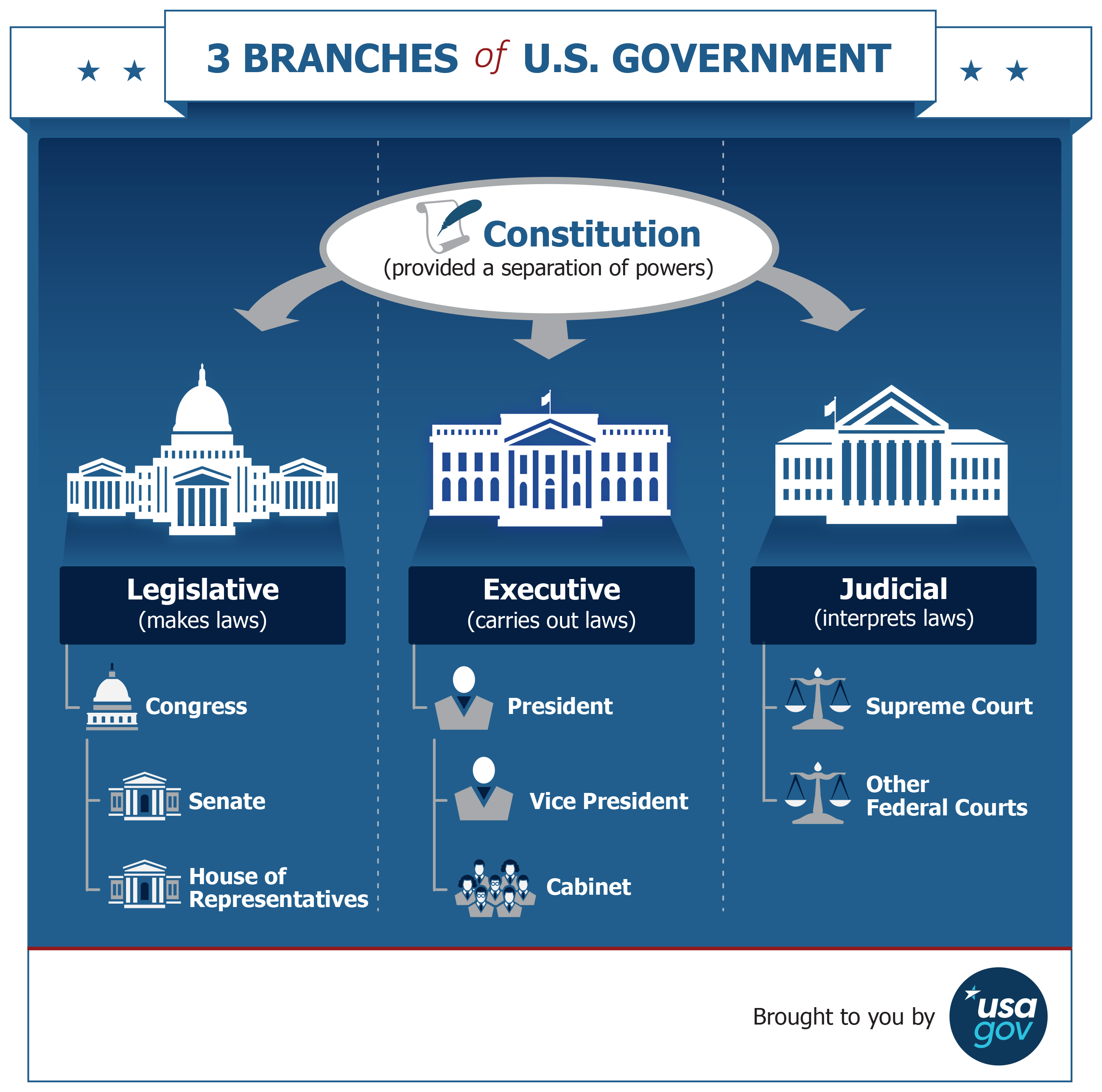
Article I of the Constitution establishes the legislative branch through a bicameral legislature. The House of Representatives, with elections every even-numbered year, has 435 members, with representation determined proportionately by state population as determined by a census every decade. The most populous state, California, has fifty-three representatives, while several states have only one representative. The House is led by the Speaker of the House, typically from the party that holds the majority seats in the House. The House is generally thought to represent the most contemporary views of the American public, with its large body of members and frequent elections.
As a check on the majority will, and on the power of larger states, the Senate is a smaller body with one hundred members (two from each state) and with less frequent elections (every six years). The Senate is meant to be a deliberative body to ensure debate of significant issues and prevent hastily rushed law. The makeup of the Senate means that citizens from smaller states, representing many fewer people, may frustrate the will of the majority of Americans. The Constitution places the power to legislate with both chambers, but the House retains the exclusive right to originate bills raising revenue (taxation), while the Senate maintains the exclusive right to ratify treaties.
Article II of the Constitution establishes the executive branch of government. It sets forth some of the mechanisms for becoming president—and is the only place in the Constitution that prescribes a specific oath of office. Article II grants the president power to be the primary architect of foreign affairs, including the power to negotiate treaties and appoint ambassadors. The president is also commander-in-chief of the armed forces. The president is mainly responsible for enforcing the laws of the nation. Through prosecutorial and police functions, the president ensures that the will of the people, as expressed through Congress, is carried out.
Article III of the Constitution establishes the judicial branch of the federal government. The judicial branch plays a critical role in interpreting the Constitution and outlining the powers of the legislature and executive branches. The power to adjudicate disputes is given to the Supreme Court and any other lower courts established by Congress. Federal courts have the power to hear disputes under the Constitution, federal laws and treaties. Also, if disputes arise between citizens of different states, a federal court may have diversity jurisdiction. Federal judges are nominated by the president and confirmed by the Senate. Federal judges serve for life, which helps insulate them from political pressures.
Checks and Balances
The Constitution establishes a system of checks and balances among the legislative, executive, and judicial branches. Under this system, each branch of government restrains the power of the other two branches of government. For example, the president may veto a bill passed by Congress. And Congress can override a presidential veto by a two-thirds vote.
Figure 5.2 Checks and Balances of the Federal Government
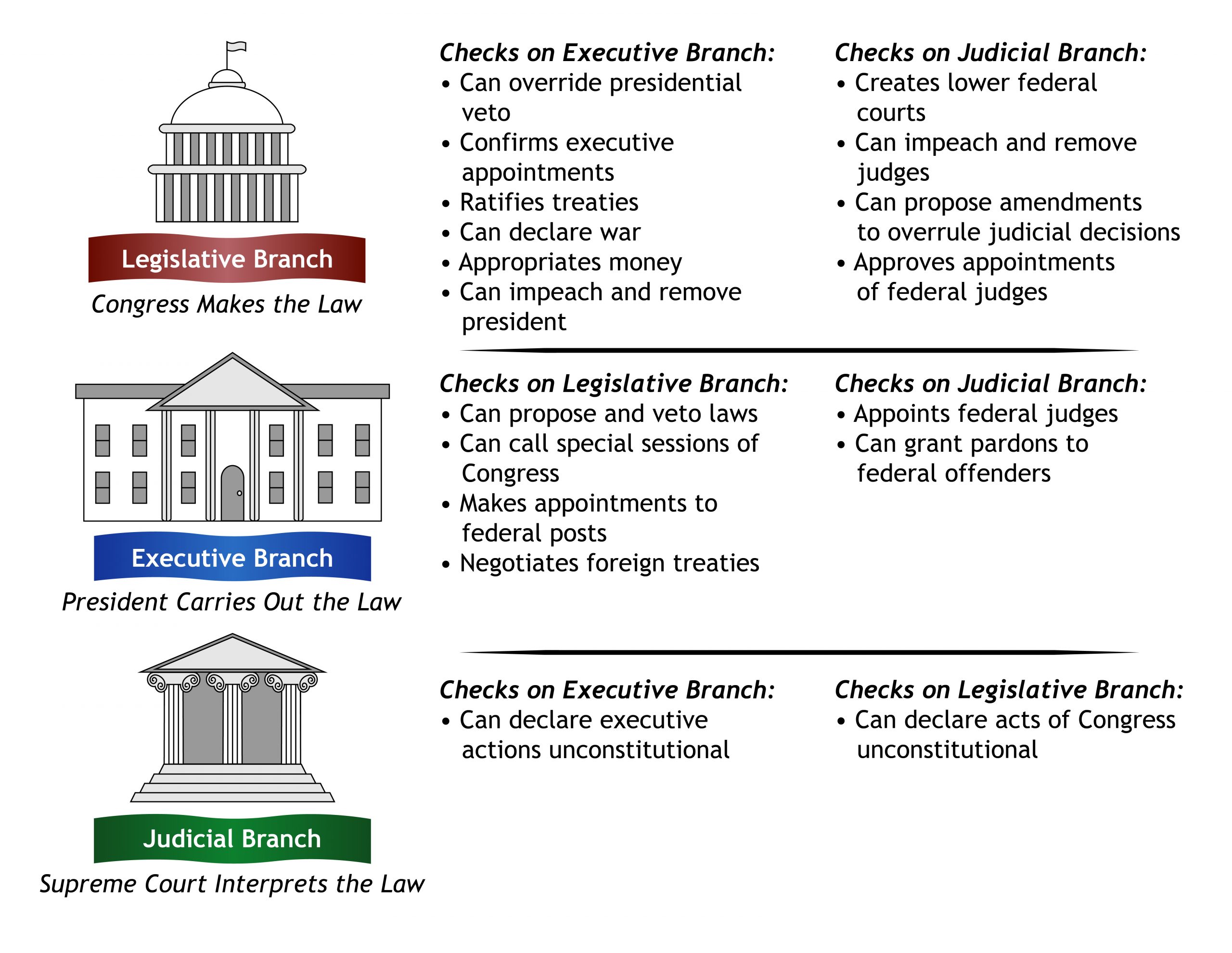
The judicial branch has the power of judicial review of executive and legislative actions to determine whether they violate the Constitution. Although not expressly written in the Constitution, judicial review was established in 1803 in a landmark case, Marbury v. Madison. Judicial review also includes review of state action for violations of the US Constitution. As a result, judicial review ensures that the US Constitution is the supreme law of the land and that the judicial branch has the authority to interpret the Constitution.
Federalism
Another aspect of the separation of powers is the separation of power between the federal and state governments, known as federalism. To avoid tyranny, the Constitution grants certain powers to Congress, reserving all other powers to the states. This is a result of the Founders’ distrust of a central government and their effort to address the failures of the Articles of Confederation. These powers are listed in Article I, Section 8 and are called enumerated powers.
Congress has the power to borrow money, lay and collect taxes, regulate interstate commerce, establish a uniform law on bankruptcy and naturalization, make money and establish its value, punish the counterfeiting of US money, and establish a uniform system of weights and measures. Congress also has the power to establish post offices and to protect intellectual property in copyrights and patents. Congress can create lower courts under the Supreme Court created in Article III and to define crimes committed on the “high seas” and against the “law of nations.” Congress is also given fiscal responsibility over the armed forces.
State Police Powers
The Constitution reinforces that states have police power, which is the authority to regulate public safety, health, welfare, and morals. States may grant more civil rights to its citizens than the federal government does. For example, some states have passed anti-discrimination laws that protect more minority groups than are recognized by the federal government. States are permitted to do so as long as the exercise of their power does not violate the US Constitution. Generally, this means the state legislation must be reasonable and applied fairly rather than arbitrarily.
Concurrent Powers
The federal and state governments have some of the same powers, which are called concurrent powers. For example, both federal and state governments may tax businesses and individuals. States are permitted to tax, but only if the activity taxed has a nexus to the state. A transaction (such as a sale) that takes place inside the state creates a nexus for a sales tax. Working in the state typically creates a nexus for state or local income tax to apply, and owning real property creates a nexus for real estate tax to apply.
Figure 5.3 Venn Diagram of the Powers of the Federal and State Governments
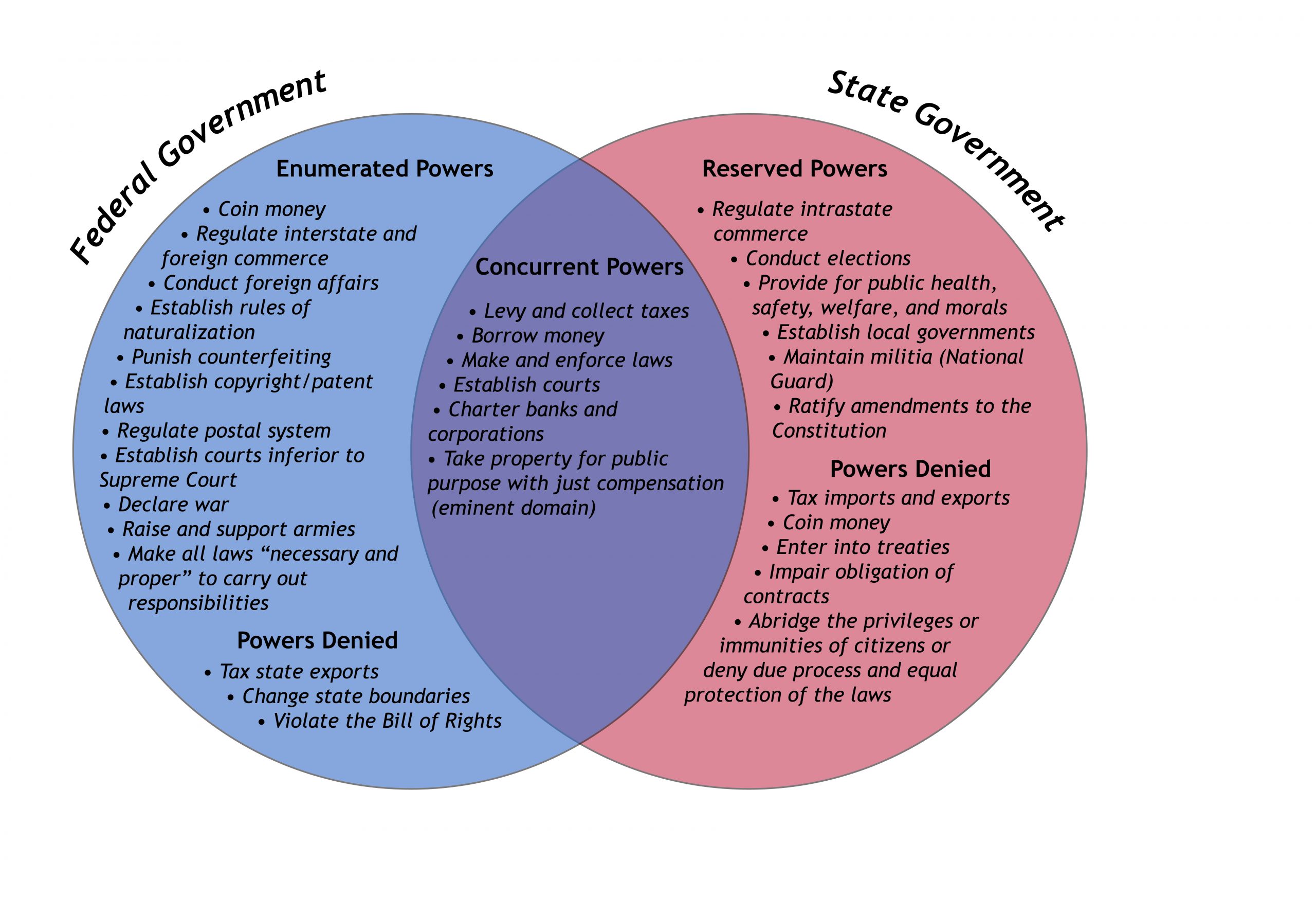
What happens, however, if a state’s citizen purchases goods from a seller out of state? Traditionally, buyers do not pay sales tax to the government directly—rather, they pay the sales tax to the seller, who collects the tax on behalf of the government and turns it over to the government at regular intervals. As the popularity of e-commerce has skyrocketed, more and more states are reexamining how to tax transactions from out-of-state sellers by compelling those sellers to collect the applicable state sales tax. In June 2018, the US Supreme Court ruled that states may impose sales tax on e-commerce sales on businesses that do not have a physical presence within the states’ boundaries. If the business has a clear connection to state consumers and generate a certain threshold of sales, a state can collect sales tax.
Preemption
What happens when state and federal laws exist on the same subject matter and they contradict each other? Under the Constitution’s Supremacy Clause (Article VI, Section 2), the Constitution, federal laws and treaties are the “supreme law of the land” and judges in every state “shall be bound” by those laws. This means that federal laws are superior to state laws. Therefore, when a federal law conflicts with a state law, the federal law prevails.
When Congress states its intent to regulate an area completely, this is called express preemption. Implied preemption occurs when Congress intends to completely regulate an area but does not say so explicitly. Instead, Congress passes laws that “occupy the field” so much that no room for state regulation exists. Finally, some areas of the law allow both state and federal governments to regulate together. For example, both federal and state governments have laws to protect consumer rights.
Constitutional Rules Between the States
There are several important Constitutional provisions that ensure our federalist system works properly. The first is the Privileges and Immunities Clause in Article IV. This Clause ensures that people in different states are treated equally by the government. For example, the federal government cannot pass laws that subject citizens in the West to more regulations than citizens in the East. Federal laws must be applied equally across the nation. The Founders included this provision to encourage travel and business between the states.
Another important Constitutional provision is the Full Faith and Credit Clause in Article IV. This Clause requires states to “respect the public acts, records, and judicial proceedings of every other state.” This is important for businesses because it ensures that state courts respect the judgments of courts from other states. Therefore, a judgment won in Colorado may be enforced in another state, without relitigating the underlying issues. This facilitates business because litigation can be finalized without subjecting a company to endless liability across states.
5.3 The Commerce Clause
The most important Constitutional provision related to the federal regulation of business is the Commerce Clause, which grants Congress the power to “regulate Commerce with foreign Nations, and among the several States, and with the Indian Tribes” (Article I, sec. 8). Over time, the Commerce Clause has been interpreted to apply to more and more businesses and industries. In addition to business transactions across state lines, the Commerce Clause now applies to business activity within one state that substantially affects or impacts commerce in other states. The growth of e-commerce, the internet, and federally-insured banks results in most businesses today being subject to federal regulation under the Commerce Clause.
Dormant Commerce Clause
States cannot interfere with Congress’s power to regulate interstate commerce. This concept is known as the Dormant Commerce Clause. This clause restricts the states’ abilities to regulate commerce, rather than the federal government’s.
A state law that discriminates against out-of-state commerce, or places an undue burden on interstate commerce, violates the dormant commerce clause. For example, if a state required out-of-state corporations to pay a higher tax or fee than an in-state corporation, that is unconstitutional. However, this prohibition against out-of-state discrimination does not prevent a state from exercising its police power to protect state citizens, as long as the power is exercised evenly and equally. For example, a state may weigh trucks on highways to ensure they do not exceed maximum weight rules, even if the trucks came from out of state, as long as all trucks on the highways are weighed.
5.4 Business and the Bill of Rights
During the debate surrounding the Constitution, there was much discussion about whether an explicit protection of civil liberty was necessary. Some believed that the common law system adequately protected civil liberties, so a written declaration of rights wasn’t necessary. Others believed that a written declaration of rights was necessary to protect the people from government overreach. In 1791, the first ten amendments to the Constitution were ratified and became known as the Bill of Rights.
When we speak of civil liberties protected in the Constitution, we often think of how these liberties apply to people. Although the Constitution does not contain the word “corporation,” Congress has defined “person” to include “corporations” so many civil rights also apply to business entities.
It’s worth making some observations about civil liberties in general. First, there are no absolute rights, in spite of the wording of any specific amendment. For example, the First Amendment states that “Congress shall make no law abridging the freedom of speech.” In fact, there are many laws that limit the freedom of speech. People aren’t allowed to libel or slander someone, for example, or incite a crowd into a riot. Instead of absolute rights, courts have to constantly balance competing interests in deciding where the limits of individual rights lie. The right of the public to know information about the lives of politicians and other high-profile figures, for example, must often be balanced by the right those citizens have to their own privacy.
Second, while the Constitution sets up a system of government based on principles of representative democracy, the Bill of Rights exists to protect the minority, not the majority. Other than the right to vote, the civil liberties protected by the Constitution extend to all persons physically on US soil, not just citizens or legal immigrants. Persons visiting the United States temporarily, such as tourists and students, as well as undocumented aliens, are also entitled to the full protections of the US Constitution.
Third, the extent of civil liberty protections vary from time to time. Society evolves with progress and challenges. The Founders could not contemplate a digital world where an act of defamation on social media can spread to millions of people in a matter of minutes. The Eighth Amendment illustrates how time shifts the meaning of a right. The Eighth Amendment prohibits “cruel and unusual” punishment. The Supreme Court, in defining what “cruel and unusual” is, looks to “evolving standards of decency” in making the determination—in other words, what is cruel and unusual today may have been normal in years past.
Finally, major portions of the Bill of Rights apply equally to the states as they do the federal government. When adopted, the amendments were meant to restrict the federal government only. For example, the First Amendment states “Congress shall make no law respecting an establishment of religion.” States were not similarly restricted, and many states established official churches. After the Civil War, the Constitution was amended to include the Fourteenth Amendment, which prevents any state from depriving citizens of their rights without “due process of law.” Gradually, the Supreme Court developed a doctrine called incorporation, by which the limitations on government behavior in the Bill of Rights were extended to apply to the states as well. While many portions of the Bill of Rights apply to the states, not all of it does. There is no requirement, for example, that states use a grand jury system to indict criminals. There is also no requirement that states provide juries in civil trials.
First Amendment
Figure 5.4 Language of the First Amendment
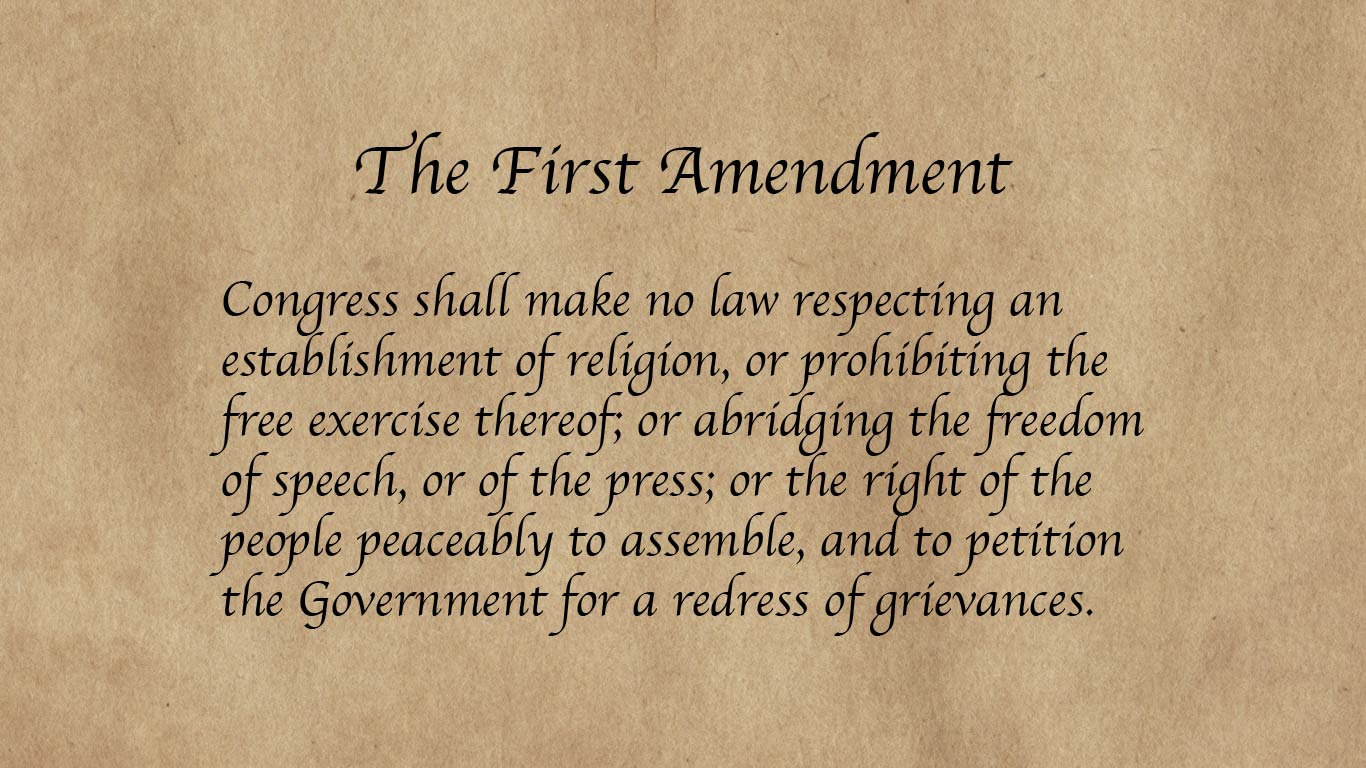
The First Amendment contains several important clauses pertaining to speech and religion. The two different clauses on religion may conflict with each other in some circumstances. On the one hand, the First Amendment prohibits the government from establishing any religion—this is called the Establishment Clause. On the other hand, the First Amendment prohibits the government from restricting the free exercise of religion—this is called the Free Exercise Clause. In theory, this allows individuals the right to freely practice their religion while prohibiting the government from doing so. Conflict arises when people choose to practice their religion freely and openly on government property, such as in a public school or city hall.
As is often true in Bill of Rights cases, courts have had to fashion a test to draw the line between the Establishment and Free Exercise Clauses. The use of public funds for religious purposes and the public display of religious life is generally acceptable as long as the primary motivation is not to advance a specific religion. A city that wishes to display a Christmas tree or nativity scene, for example, is permitted to do so as part of a general holiday-themed cultural display that also includes a menorah.
The First Amendment also protects the right to freedom of speech. While many nations believe in the right of citizens to think and speak freely, the United States is fairly unique in enshrining those principles into constitutional law.
Not all speech is protected by the First Amendment, and the type of speech drives its level of protection. Political speech, which relates to matters of public interest, receives the most protection. Political dissent, displeasure with the government, party membership, and even speech advocating the overthrow of government, all deserve extraordinary protection under the First Amendment.
Figure 5.5 Spectrum of First Amendment Protection of Speech

On the other end of the spectrum is speech that deserves no protection under the First Amendment at all, such as speech that incites a panic (e.g. yelling “Fire” in a crowded theater when there is no fire). Defamation, libel and slander are all actionable torts. Obscene speech and fighting words are also not protected under the First Amendment.
In the middle of the spectrum is commercial speech, which relates to business transactions. Commercial speech is entitled to some protection under the First Amendment as long as it is not false or misleads consumers. If the information is false or misleading, it is not protected at all. Under an intermediate level of scrutiny test, freedom of commercial speech is not violated as long as (1) there is a substantial government interest in restricting or regulating speech; (2) the restriction directly advances that interest, and (3) the restriction is no more extensive than necessary.
The prior restraint doctrine prohibits formal censorship before the publication of speech. In other words, the government cannot restrict speech or publications before their actual expression. Prior restraints violate the First Amendment unless the speech is obscene, is defamatory, or creates a clear and present danger to society.
The US Supreme Court has ruled that corporations are “persons” entitled to First Amendment rights to speech and religion. In striking down federal and twenty-two state restrictions on corporate spending on political campaigns, the Supreme Court held that corporations are persons and therefore entitled to engage in political speech. Since corporations are unable to literally “speak,” they speak through spending money, and thus restrictions on how corporations may spend money during political campaigns are unconstitutional. Similarly, Congress defined “persons” to include corporations, companies, associations, firms, partnerships, societies, and joint stock companies. As a result, those types of businesses have religious rights that allow them to opt out of providing healthcare insurance to their employees that violates the businesses’ religious beliefs.
Not all protected speech is protected all the time in all places. The government is permitted to place reasonable time, place, and manner restrictions on speech to maintain important governmental functions. These restrictions are generally upheld if they further an important or substantial governmental interest, they are content neutral, and any restriction on First Amendment freedoms is no greater than that necessary to further governmental interests (i.e. the restriction is not overbroad). Thus, for example, courts have upheld restrictions on posting signs on city-owned utility poles, as well as picketing and protest permit requirements.
Fifth Amendment
Figure 5.6 Langue of the Fifth Amendment
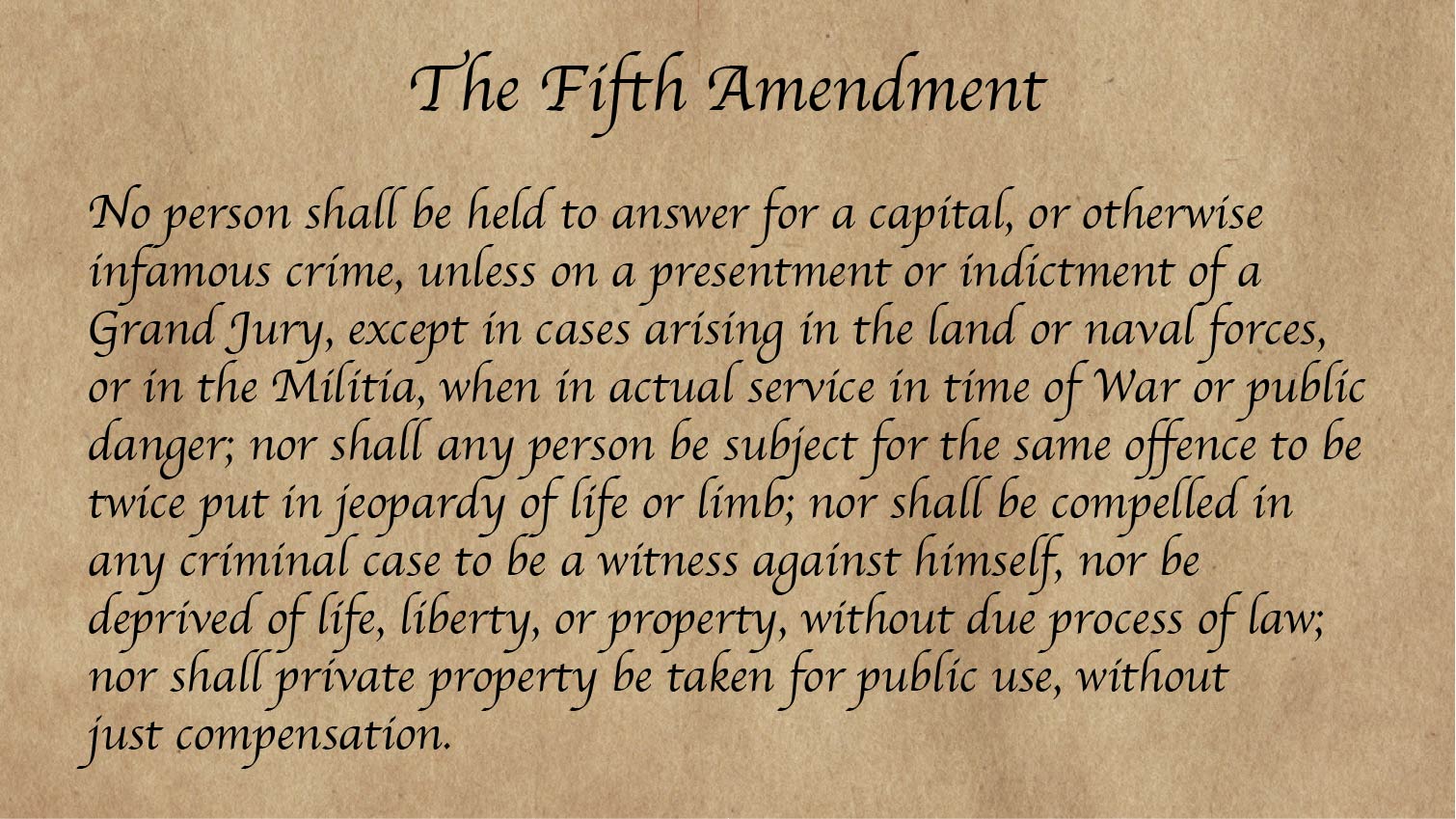
Another important restriction on governmental authority actually appears twice in the Constitution. The due process clause appears in both the Fifth Amendment (“No person shall…be deprived of life, liberty or property without due process of law”) and the Fourteenth Amendment (“Nor shall any State deprive any person of life, liberty, or property, without due process of law”). The Fifth Amendment applies to the federal government and to the states. At its core, due process means “fundamental fairness and decency.” The clause requires that all government action that involves the taking of life, liberty, or property be done fairly and for fair reasons. Notice that the due process clause applies only to government action—it does not apply to the actions of private citizens or entities such as corporations.
Due process contains two components. The first is called procedural due process. Procedural due process requires that any government action that takes away life, liberty, or property must be made fairly and using fair procedures. Procedural due process includes: (1) notice that the government is going to act and why; (2) a hearing prior to the governmental action; and (3) the ability to appeal the determination made at the hearing. This ensures those affected by a government action have a fair chance to oppose it.
The second type of the due process is substantive due process. Substantive due process focuses on the content of government legislation itself. Generally speaking, government regulation is justified whenever the government can articulate a rational reason for the regulation. In certain categories, however, the government must articulate a compelling reason for the regulation. This is the case when the regulation affects a fundamental right, which is a right deeply rooted in American history and implicit in the concept of ordered liberty. The government must also set forth compelling reasons for restricting the right to vote or the right to travel. Substantive due process is often used as a basis for any lawsuit challenging government procedures or laws that affect an individual’s or company’s civil liberties.
Governments have the power of eminent domain, which is the power to take privately owned property and convert it for public use. The Takings Clause of the Fifth Amendment prohibits the government from taking private property for public use without just compensation. A law or regulation that denies all beneficial use of property is a taking that requires compensation. A common issue in eminent domain cases is what constitutes “just compensation.” What the value of the property was before the government announces its intent to take the property or after? Property includes land, intellectual property, and personal property.
Fourteenth Amendment
Figure 5.7 Language of the Fourteenth Amendment
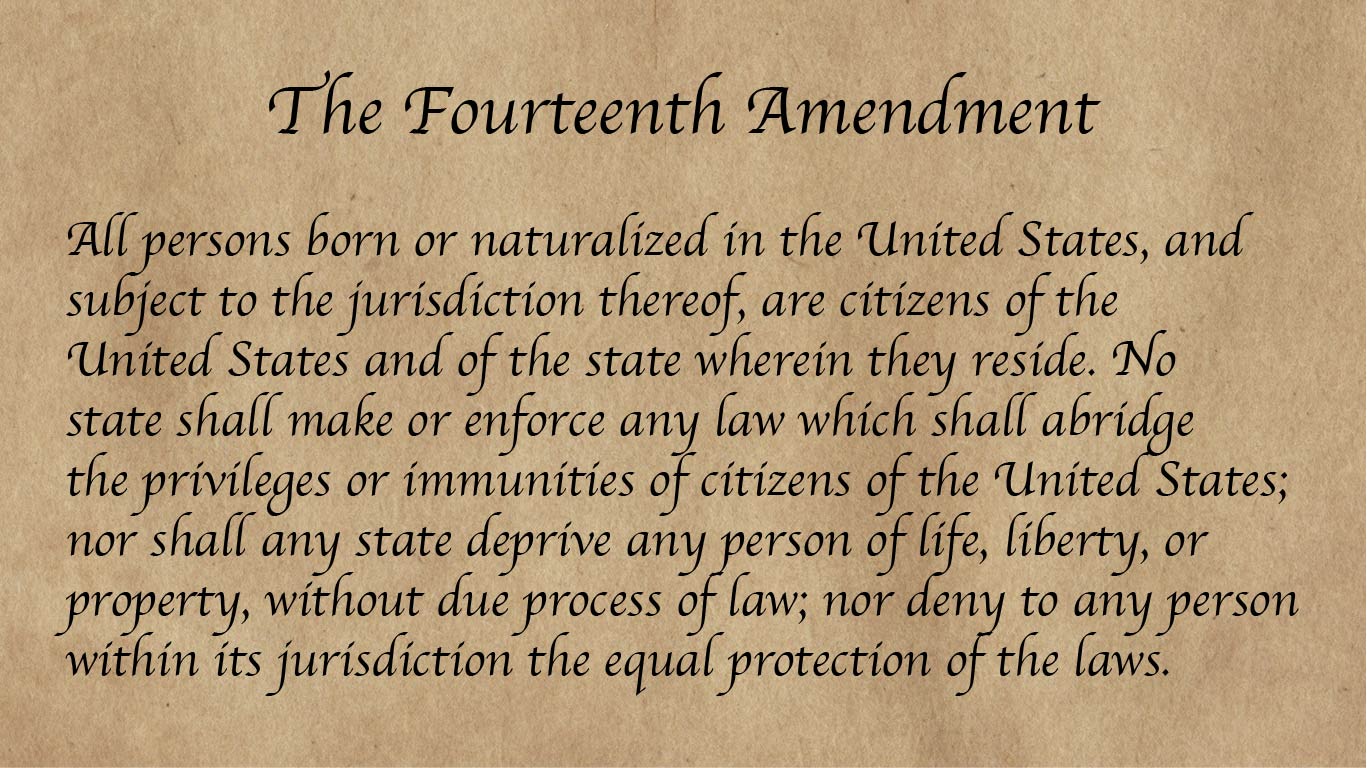
The Equal Protection Clause of the Fourteenth Amendment states that “No state shall deny to any person within its jurisdiction the equal protection of the laws.” In other words, it requires the government to treat people equally. This clause incorporates Constitutional protections against the states in addition to the federal government.
The Equal Protection Clause is implicated anytime a law limits the liberty of some people but not others. It scrutinizes government-sponsored discrimination. While the word “discrimination” has a negative connotation, not all discrimination is illegal. For example, a criminal law discriminates against those who steal. The Equal Protection Clause seeks to determine what forms of discrimination are permissible.
To establish a guideline for courts to use in answering equal protection cases, the US Supreme Court has established three standards of review when examining statutes that discriminate: minimal scrutiny, intermediate scrutiny, and strict scrutiny.
Under the minimal scrutiny test, the government needs only a rational basis for the law—the law simply has to be reasonably related to some legitimate government interest. If the law is based on some rational basis, then the law passes equal protection. Thus, a law that imprisons thieves easily passes minimal scrutiny, since there are many rational reasons to imprison thieves. The majority of cases that are scrutinized under minimal scrutiny pass review.
The intermediate scrutiny test applies to cases where the government discriminates on the basis of gender. Under this test, the government has to prove that the law in question is substantially related to an important government interest. Using this test, courts have invalidated gender restrictions on admissions to nursing school, laws that state only wives can receive alimony, and a higher minimum drinking age for men.
The strict scrutiny test is used when the government discriminates against a suspect class. Under this test, the government has to prove that the law is justified by a compelling governmental interest, that the law is narrowly tailored to achieve that goal or interest, and that the law is the least restrictive means to achieve that interest. The standard is reserved for only a few classifications: laws that affect “fundamental rights” such as the rights in the Bill of Rights and any government discrimination that affects a “suspect classification” such as race or national origin. In practice, the government has a hard time meeting this burden.
| Test | Relationship | Governmental Interest | Likely Result |
| Strict Scrutiny | Necessarily relates | Compelling | Governmental action is likely unconstitutional |
| Intermediate Scrutiny | Substantially relates | Important | Case-by case determination |
| Rational Basis | Reasonably relates | Legitimate | Governmental action is likely constitutional |
There are a few cases where the Supreme Court has held that racial discrimination may be permissible even under strict scrutiny. For example, cases challenging affirmative action policies in higher education have held that admission preferences for underrepresented racial groups does not violate the Constitution. The Supreme Court has found that diversity in higher education is a compelling state interest, and that schools could consider race in deciding whether to admit students, as long as race is a “potential plus factor” considered with other factors.
5.5 Concluding Thoughts
The US Constitution is the most important and fundamental law in the nation. The Constitution establishes our government structure, identifies the powers of the branches, and identifies our fundamental rights. In this age of e-commerce, the vast majority of businesses are engaged in interstate commerce and are, therefore, regulated by Congress under the Commerce Clause. The Dormant Commerce Clause prevents states from unfairly burdening interstate commerce. Although the Bill of Rights is often thought of as applying to individuals, it also grants civil liberties to businesses.
The Constitution is mainly a structural document, setting forth the allocation of power among the three branches of the federal government and the limitations on that power. It is concerned mainly with what the government cannot do, as opposed to what the government must do. Article I of the Constitution establishes a bicameral legislature, with the House of Representatives and Senate. Both chambers must agree before legislation can be passed. Article II of the Constitution establishes the executive power in the president, who must enforce the laws passed by Congress. Power is also divided between state and federal governments under federalism. The Supremacy Clause states that when there is a conflict between state and federal law, federal law wins. If there is no direct conflict, the state law survives unless Congress expressly preempts state law or occupies the field. The Constitution also provides rules to facilitate state laws across state lines.
The Bill of Rights provides key civil liberties to all people on US soil. These liberties are not absolute. Many of the restrictions on government activity found in the Bill of Rights also apply to the states through incorporation.
The First Amendment prohibits the government from establishing religion and from restricting the free exercise thereof. The First Amendment also prohibits the government from restricting the freedom of speech. Political speech is protected to the fullest extent by the First Amendment, while obscene and defamatory speech is not protected at all but subject to the doctrine of prior restraint. Generally speaking, the government may impose reasonable time, place, and manner restrictions on the delivery of speech.
Procedural due process requires that the government use fair procedures anytime it seeks to deprive a citizen of life, liberty, or property. Substantive due process requires the government to articulate a rational basis for passing laws or, when fundamental rights are involved, to articulate a compelling reason to do so.
